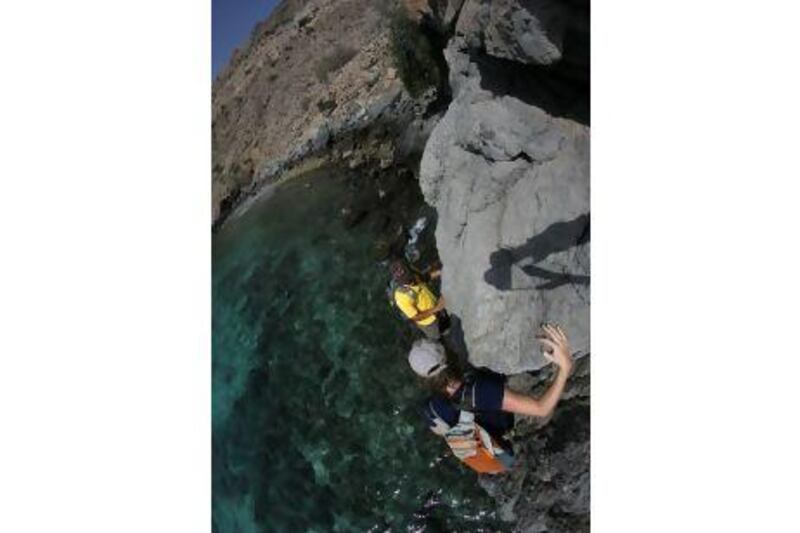"Just remove all unnecessary thoughts." Vishnu Prasad, Six Senses' resident guru from Kerala, makes it sound so easy. As indeed it is when you have just walked barefoot at sunrise on the sandy beach, had a swim in the perfectly quiet bay, and enjoyed a cup of tea in your own peaceful villa and a personalised outdoor pranayama session at the yoga pavilion. Not to mention a gourmet tasting menu at Sense on the Edge, 293m above sea level, the night before.
It's only 8am, and as I lie back on my mat with the warm sun on my face it feels as though my day - and weekend - has peaked.
Yet it's barely even begun. Because as much as one can simply enjoy the resort, one of Six Senses' best assets is its location in the starkly beautiful - and empty - mountains of Musandam. After a breakfast of fresh carrot juice, juicy cut fruit and a fabulous shanklish-and-honey-filled manakeesh, we're picked up by the Dibba-based company Absolute Adventure.
Our guide Sebastien Le Bon, from Mauritius, is driving a giant but surprisingly agile bright yellow Chevrolet Tahoe and wastes no time in whisking us up through Wadi Khabbash Shamsi towards the Sabateyn plateau. In half an hour, we meet just one other vehicle.
There has been some rain recently, and the gorge is scattered with acacia, latab and cedar trees that draw water from deep underground. "The roots of these trees are often 45m deep," says Sebastien. He stops the 4x4 and we begin a climb up what he calls the "secret staircase". It's a hand-built path up to Al Hajjar, a mostly abandoned village 670m above sea level. "After the discovery of oil in Oman in the 1960s and 70s, many locals here got the opportunity to go to towns and get educated," he says. "Now the landowners hire Pakistanis to look after the land."
The land, barren as it is, supports herds of goats and features ancient terraces which are, amazingly, still used to grow wheat and barley in the winter months. There are a couple of small huts, goats and chickens, some outdoor clay ovens and, finally, a cemetery with petroglyph-type carvings on the simple headstones.
“These were for the richest or most important women of the village,” says Sebastien; in the eerie stillness, it’s strange to think of the place as a once-thriving farming community. We look across to Musandam’s highest point, Jebel Harim, before heading back down. We drive farther along the road to Sabateyn, which until 1975 had a population of 250, according to Sebastien. Now there are just 150 goats, although the owner, who moved to Fujairah, has now apparently moved back.
Overlooking the plateau at 1,200m, while eating a delicious gourmet lunch of salads, sandwiches, fresh juices and chocolate brownies provided by Six Senses, Sebastien explains that there are three main tribes in Musandam and seven different dialects. Among a jumble of rocks, goats and dry rock huts at Sabateyn, Sebastien shows us what he thinks are petroglyphs – striking images of camels hewn into the side of some rocks. According to local historians, these could be up to to 2,000 years old. Yet even that is nothing compared to the age of these mountains. Caused by a rift between two plates, the spectacular Sabateyn mountains still display sediment lines from when the rock was underwater some 300m years ago.
We pass a small group of picnicking Germans before beginning the hour-long descent back to Zighy Bay, the afternoon light casting shadows on the canyon walls and lulling us, after our lunch, almost to sleep.
“Today, we’re hiking from Jordan to Peru.” It’s 11am the following day and after a more leisurely breakfast and last-minute consultations about the weather, we’re joined again by Sebastien, who this time is at the helm of a speedboat. We zip out of Zighy Bay’s new marina and head north up the east coast of the Musandam Peninsula with Absolute Adventure’s trekking guide for the day, Ram Thapa. Appropriately, he’s from Nepal, and led treks through the Annapurnas before landing in Dibba eight years ago. Just north of Zighy Bay, we pass a huge white -limestone cave; apart from a few tiny settlements, the brooding mountains are empty until we get to the tiny fishing village of Aqaba, in an azure bay reminiscent of coastal Greece.
Resisting the temptation to jump straight off the boat into the water, Sebastien drops us on the beach and we put on our trail shoes for the two-hour hike to Lima, a larger settlement further up the coast. We follow Ram as we pick our way along a gorgeous route which starts by following the coastline. Clinging on to the side of rocks, we inch our way round the headland and begin a steep upward climb to the original post of Aqaba, high on the hillside. Here, there are dozens of ruined stone houses; Ram explains that, just like Sabateyn, Aqaba had a much bigger population until just 40 years ago. There used to be some 250 houses here – almost a small city by Musandam standards – but now there are just 90, lying in ruins, some complete with their stone wheat grinders and earthenware pots. There’s even a mosque and a jail built into the rock. It’s wonderfully atmospheric and scenic. Far below, empty bays shimmer and fig trees cling to the wadi floors.
Reaching a ridge line, we soon see Lima below us – a town of around 2,000 people in a scenic palm-filled valley.
Down at the bottom, we stop at Absolute Adventure’s very own farm and pick “sour berries”, or abu al haffa, from the trees for refreshment. We’re surprised and delighted to find a freshwater swimming pool waiting for us in the middle of a date plantation: after the sweaty hike, it’s the perfect antidote.
We continue towards the coast across a fertile plateau and soon reach the town’s harbour, where Sebastien is waiting. Huge shoals of sardines are being chased by tuna as we eat bento boxes of spicy summer rolls, sandwiches and more fresh juices.
Yet our adventure isn’t over yet – the sun is beginning to drop as we reach a snorkelling stop at Lima Island, 10 minutes offshore. I snorkel over huge corals with 30m visibility and a good variety of fish before climbing back into the boat. We motor back to Zighy with the wind in our hair; the sun setting behind the mountains turning the different layers into a palette of blacks and greys and tuna leaping out of the water as they feed on sardines.
Back at Six Senses’ spa, Vishnu is waiting. I’ve booked a one-hour “wellbeing massage” and he applies oil in long sweeping strokes while still managing to root out all my knots. “This is to increase circulation and detox the body,” he says. Afterwards, I feel a little queasy, as if my cold-like symptoms have been accelerated and removed in one swift move. There’s nothing for it but to lie down with some ginger tea. “Remove all unnecessary thoughts,” Vishnu said – and here, after these two days, it all seems to make sense.
If You Go
Pool villas at Six Senses Zighy Bay (www.sixsenses.com; 00 968 26735 888) cost from US$1,291 (Dh4,740) per night, including taxes. The Aqaba-Lima Trek costs 115 Omani rials (Dh1,097) per person, including a "healthy hiker" lunch and taxes (minimum four persons per trip). The Sabateyn 4x4 excursion costs 70.5 rials (Dh672) per person, including taxes but excluding lunch; picnics cost from 29.3 rials (Dh280) per person, including taxes (minimum two people per trip).





